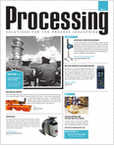Display problem ? Click HERE
Recommended :
Subscribe FREE - Processing Magazine
 Water hammer or pipeline surge is one of the phenomenon occur so quick (in mili second) without operator notice and aware that the surge has begun, progressed and ended. It some time lead to pipeline damage , leak and catastrophe.
Water hammer or pipeline surge is one of the phenomenon occur so quick (in mili second) without operator notice and aware that the surge has begun, progressed and ended. It some time lead to pipeline damage , leak and catastrophe.
Subscribe FREE - Processing Magazine
 Water hammer or pipeline surge is one of the phenomenon occur so quick (in mili second) without operator notice and aware that the surge has begun, progressed and ended. It some time lead to pipeline damage , leak and catastrophe.
Water hammer or pipeline surge is one of the phenomenon occur so quick (in mili second) without operator notice and aware that the surge has begun, progressed and ended. It some time lead to pipeline damage , leak and catastrophe.Water hammer and transient flows are used synonymously to describe an unsteady flow of fluids in pipelines, although the former term usually refers to water only. Different types of flow variation can contribute to transients, varying from a single identifiable alteration to an oscillating, periodic, or pulsating disturbance. In pumping stations (where rotary pumps with electric drives are used) and water supply systems, transients are normally governed by a change in the operational status of the pumps or valves, by varying demand experienced by the system, or by unpredictable circumstances such as pipeline or power failures.
The following document provides an overview of the theories describing surge phenomena in close conduit systems. Attention is also given to calculation methods used to determine surge pressures. The value of a holistic procedure (Transient Risk Assessment Procedure, TRAP) to determine the possible causes of surge pressures is emphasized and various measures that can be taken to p event excessive pressures are discussed.
Download (thanks to astro)
Related Post
The following document provides an overview of the theories describing surge phenomena in close conduit systems. Attention is also given to calculation methods used to determine surge pressures. The value of a holistic procedure (Transient Risk Assessment Procedure, TRAP) to determine the possible causes of surge pressures is emphasized and various measures that can be taken to p event excessive pressures are discussed.
Download (thanks to astro)
Related Post
- Check Valve Types and Selection
- Potential Problem associate with Double NRV in Series within a Line
- Several Strategies To Minimize Relief Capacity in Back-Flow Scenario
- Flow Element (FE) Upstream or Downstream of Control Valve (CV) ?
- Why a globe valve is located downstream of manual block valve on drain line ?
- How to Select a Check Valve (NRV) Quantitatively ?
- Why bypass Non-Return Valve (NRV) ?
- Potential Problem associate with Double NRV in Series within a Line
- Basis & Tips on Setting Centrifugal Pump "Warming" Recycle Flow
No comments:
Post a Comment